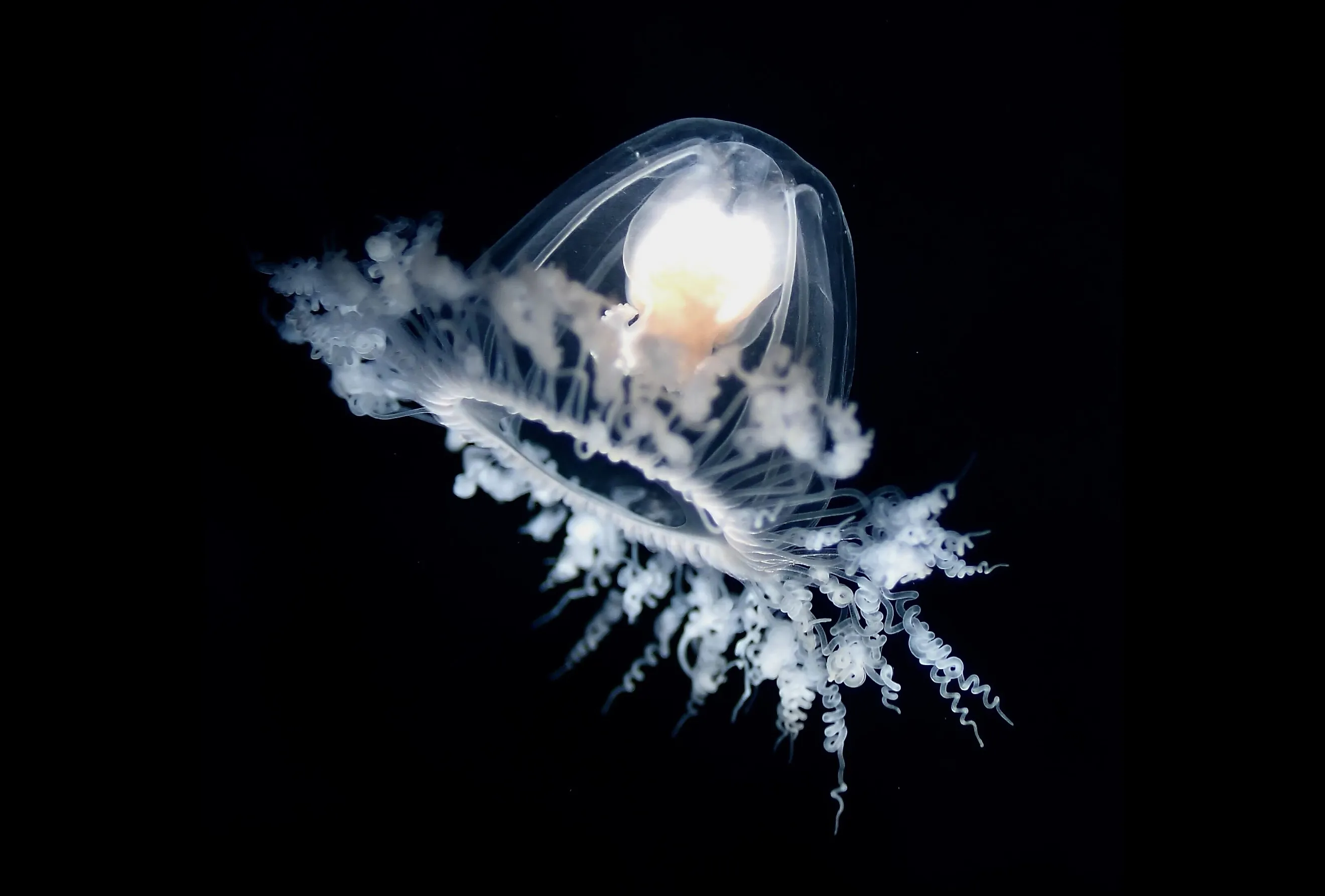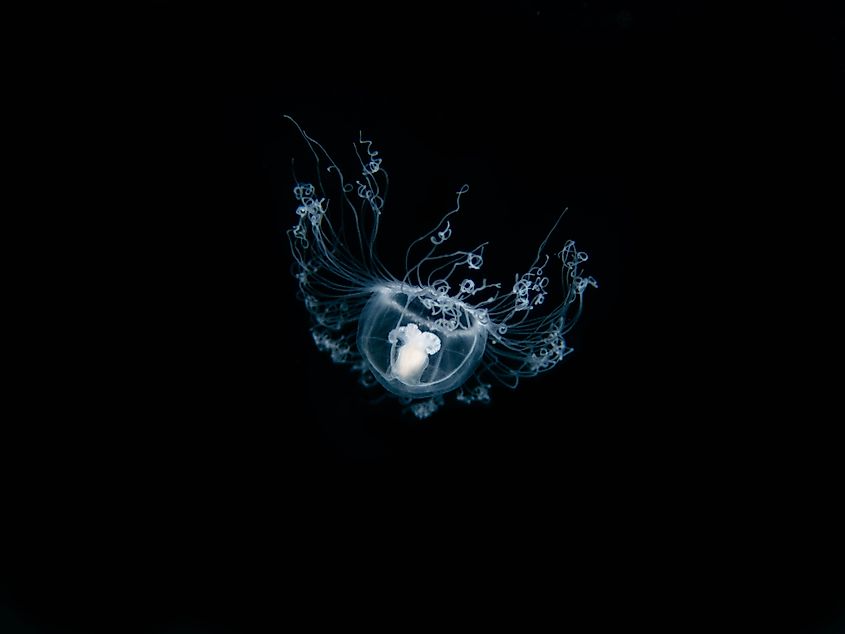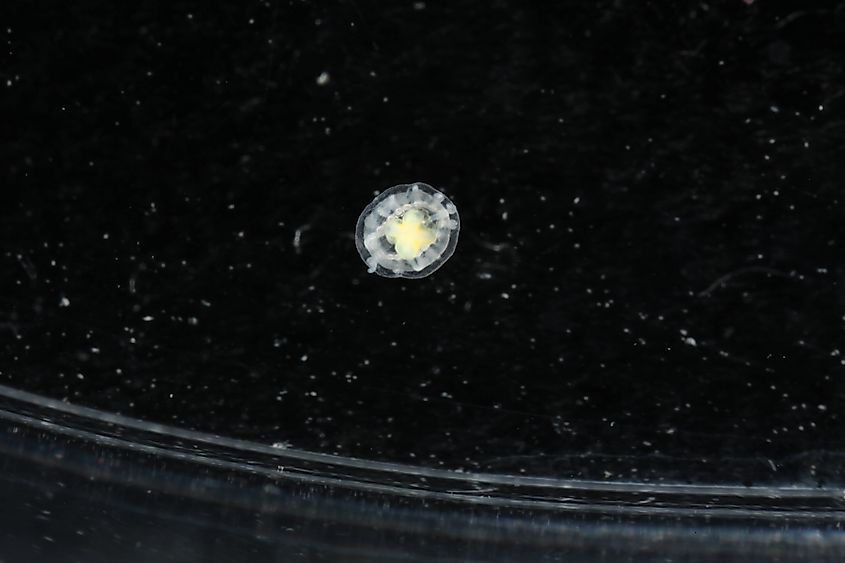
The Immortal Jellyfish That Cheats Death
Imagine a butterfly shrinking back into a caterpillar to begin life anew. Beneath the waves, a fingernail-sized wanderer performs that very miracle.
When injury, hunger, or turbulence strikes, Turritopsis dohrnii, the so-called immortal jellyfish, folds its gelatinous sails, sinks to the seabed, and rewinds its biological clock, transforming from free-swimming medusa to static polyp before budding off genetically identical clones.
Through a rare cellular alchemy called transdifferentiation, this translucent drifter may avoid old age indefinitely, hitchhiking the world’s oceans and tantalising scientists with clues to regeneration, resilience, and our own elusive pursuit of longevity itself!
What Makes Them Immortal?

Most jellyfish follow a straightforward script: eggs and sperm meet, a drifting planula larva is born, it settles, becomes a polyp, then buds off juvenile medusae and, eventually, dies. One tiny creature, Turritopsis dohrnii, scarcely 4.5 millimetres across, refuses to accept that final act.
When its adult form, the medusa, is injured, starved or otherwise stressed, the creature performs a biological U-turn. The bell contracts, tentacles are absorbed, and the jelly sinks to the seabed as an inert cyst. Within a day or two that blob reorganises itself into a brand-new polyp, effectively jumping back to an earlier life chapter. From this rejuvenated stage fresh medusae bud off, each genetically identical to the original. The cellular sleight of hand responsible, called transdifferentiation, is exceptionally uncommon: specialised medusa cells are reprogrammed to become the different cell types found in the polyp.
Because the cycle can repeat indefinitely in ideal conditions, T. dohrnii is often labelled ‘immortal’; predators or laboratory mishaps, rather than ageing, are its main threats. This fingernail-sized jelly may be easy to overlook, but its unique trick is rewriting what scientists know about life, death and regeneration.
Discovery and History

The creature we now celebrate as the “immortal jellyfish” was first catalogued in Naples in 1883 and quietly filed away with its relatives. Its extraordinary talent for rewinding life remained hidden for a century, until two graduate students, Christian Sommer and Giorgio Bavestrello, began rearing tiny hydrozoans in coastal jars during the mid-1980s.
Expecting to watch the millimetre-wide medusae spawn and die like any other jellyfish, they instead found the adults collapsing into motionless cysts, sprouting stolons and polyps, then budding off new, genetically identical medusae, an apparent resurrection performed without eggs, sperm, or a larval stage.
Repeated trials showed the same result, even when the animals were starved, injured, or chilled, revealing a unique cellular reset mechanism now called transdifferentiation. Subsequent genetic work separated the species from its look-alike Turritopsis nutricula and, in 2006, formally crowned it Turritopsis dohrnii.
Today, laboratories still struggle to maintain colonies, but Shin Kubota’s Kyoto cultures, reborn more than ten times in two years, prove the loop can continue indefinitely under ideal care. What began as a curious anomaly in a student's beaker has since become a cornerstone of aging research, forcing biologists to rethink the inevitability of senescence and inspiring new quests in regenerative medicine.
Habitat and Diet

Turritopsis dohrnii lives a two-tiered existence that spans the ocean’s surfaces and its hard substrates. Genetic clues suggest the species arose in the Pacific, yet shipping traffic has ferried it, cloaked in ballast water, into every temperate and tropical sea.
Today, it drifts unnoticed in harbours from the Mediterranean to Panama and pulses through open planktonic layers off Japan. Free-swimming medusae flourish between 14 °C and 25 °C and tolerate salinities of roughly 18-40 PSU, letting them ride coastal currents, slip beneath floating docks, or hitch to vessel hulls. When stress or age forces a biological reset, the jelly sinks, attaching its stolons to rocks, pilings, or seaweed and founding branched polyp colonies that carpet the seafloor.
Its menu is as cosmopolitan as its range. A carnivore only a few millimetres wide, the immortal jellyfish snares zooplankton, fish eggs, and minute molluscs with tentacles laced in nematocysts. Medusae expand their bells to draw water and prey closer, then flex those tentacles inward to deliver the sting and guide morsels to a single mouth that doubles as an exit for waste. Mature individuals escalate their appetite, rapidly subduing fellow jellyfish, while sessile polyps rely on passing micro-organisms swept into their tiny gastric cavities.
Why It Matters
Most animals age as their cells accumulate damage, yet the “immortal jellyfish” sidesteps senescence by triggering transdifferentiation: injured or starving medusae reprogram differentiated tissues back into stem-like polyp cells, rebuild their bodies, and start life over.
Genomic studies show the species maintains telomere length, activates DNA-repair pathways, and tweaks Wnt signalling during each reversal, providing clues to how genomes can be kept youthful. Unpicking these mechanisms could inspire new therapies for degenerative diseases, extend organ viability and refine induced pluripotent-stem-cell technology. The jellyfish also gives evolutionary biologists a rare chance to study how immortality evolves and how ecosystems cope with a species lacking a built-in expiry date.
Finally, because T. dohrnii spreads quietly in ballast water without causing harm, it functions as a safe, globally available laboratory organism, if researchers can master its finicky culturing. Every pulse of its tiny bell poses a provocative question: if a jellyfish can reboot itself forever, might humans eventually do something similar? The quest continues in labs from Kyoto to Boston today.
The Takeaway
From a near-invisible speck drifting in ballast water to a beacon in longevity labs, Turritopsis dohrnii turns the ocean into a time machine and biology into possibility. Its endless loop challenges our definition of ageing, hints at therapies that patch failing hearts and nerves, and reminds us that innovation often hides in plain sight, pulsing, transparent, and barely larger than a freckle. The sea’s tiniest sailor might yet reshape human time.











